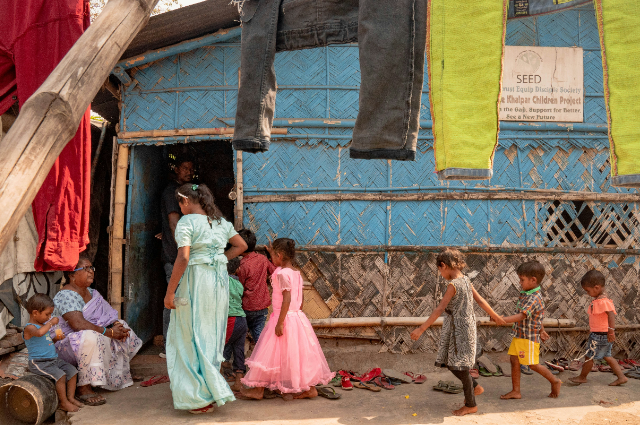
Photo by Shelby Murphy Figueroa on Unsplash
Introduction
Poverty remains one of the most pressing challenges facing humanity. Despite significant progress in various regions, more than 700 million people globally still live in extreme poverty, subsisting on less than $2.15 a day. This stark reality reveals the persistent and pervasive nature of poverty, affecting millions of lives and stalling development across many countries. The struggle to ensure that everyone has access to basic necessities like food, shelter, and education is far from over. Addressing this global issue requires a multifaceted approach, combining international cooperation, national policy reforms, and grassroots initiatives.
The Global Landscape of Poverty
As of 2023, the global poverty rate stood at approximately 9.2%, with Sub-Saharan Africa and South Asia bearing the brunt of this burden. In Sub-Saharan Africa, nearly 40% of the population lives in extreme poverty, while in South Asia, the figure is around 15%. These regions are home to some of the world’s poorest countries, where economic instability, conflict, and environmental challenges exacerbate the problem.
In contrast, regions such as Europe and Central Asia have seen significant reductions in poverty levels, thanks to robust social safety nets and inclusive economic policies. However, poverty still persists, especially among marginalized communities, including ethnic minorities, refugees, and people with disabilities. The COVID-19 pandemic dealt a significant blow to global poverty reduction efforts, pushing an estimated 97 million more people into extreme poverty in 2020 alone. This setback highlights the vulnerability of those living on the edge and underscores the need for resilient economic systems that can withstand global shocks.
Poverty in National Contexts
While global statistics paint a grim picture, the reality of poverty varies significantly from country to country. For instance, in India, despite being one of the fastest-growing economies in the world, nearly 10% of its population still lives in extreme poverty. Poverty in India remains a significant issue despite substantial economic growth over the past few decades. As of recent estimates, around 16% of India's population, or approximately 230 million people, live below the poverty line, defined as earning less than $1.90 per day.
In contrast, the United States, one of the wealthiest nations globally, has a poverty rate of around 11.4%, according to the U.S. Census Bureau. However, this figure obscures the reality that poverty disproportionately affects certain groups, such as African Americans, Hispanics, and single-parent households. In 2022, 19.5% of African Americans and 17% of Hispanics lived in poverty, compared to just 8.2% of non-Hispanic whites. Brazil, the largest economy in Latin America, faces a similar challenge, with a poverty rate of about 19%. Here, income inequality is a significant driver of poverty, with the wealthiest 10% of the population holding more than 40% of the country’s income.
The Vicious Cycle of Poverty
Poverty is not just a lack of income; it is a complex web of social, economic, and political factors that trap individuals and communities in a cycle of deprivation. The effects of poverty are far-reaching, impacting health, education, and opportunities for future generations. Children born into poverty are more likely to suffer from malnutrition, stunting, and a host of health issues that can impede their cognitive and physical development. This, in turn, affects their ability to perform well in school, reducing their chances of breaking free from the poverty cycle. In many developing countries, the lack of access to quality education is a significant barrier to upward mobility, as it limits employment opportunities and perpetuates income inequality.
Moreover, poverty often forces people into informal or low-paying jobs, where they lack social protection and job security. This precarious employment situation makes it difficult for individuals to save, invest in their education, or start businesses, further entrenching them in poverty.
Strategies to Alleviate Poverty
Addressing poverty requires a coordinated effort at both the national and international levels. Here are several strategies that can help lift people out of poverty and ensure that everyone has a piece of bread:
Inclusive Economic Growth:
Economic growth is essential for poverty reduction, but it must be inclusive and sustainable. Governments should prioritize policies that create jobs, promote small and medium-sized enterprises (SMEs), and support sectors that employ large numbers of low-income workers, such as agriculture and manufacturing. Additionally, investments in infrastructure, such as roads, electricity, and internet access, can help bridge the rural-urban divide and enable people in remote areas to participate in the economy.
Education and Skills Development:
Education is a powerful tool for breaking the cycle of poverty. Governments and international organizations should invest in early childhood education, primary and secondary schooling, and vocational training programs. In particular, there should be a focus on empowering women and girls, who are often disproportionately affected by poverty. Education not only improves individuals’ employment prospects but also has a multiplier effect on health, nutrition, and overall well-being.
Social Protection Programs:
Social protection programs, such as cash transfers, food assistance, and health insurance, are critical for providing a safety net for the most vulnerable. These programs help cushion the impact of economic shocks, such as job losses or natural disasters, and enable people to invest in their future. For instance, Brazil’s Bolsa Família program has been credited with lifting millions of people out of poverty by providing direct cash transfers to low-income families, conditional on their children’s school attendance and vaccination.
Health and Nutrition:
Good health is fundamental to economic productivity and human development. Governments should invest in accessible and affordable healthcare systems, particularly in rural and underserved areas. Additionally, nutrition programs that target pregnant women, infants, and young children can help prevent malnutrition and stunting, ensuring that the next generation has the physical and cognitive abilities to thrive.
Empowering Women:
Women are disproportionately affected by poverty, yet they play a crucial role in economic development. Empowering women through education, access to credit, and legal rights can have a transformative impact on poverty reduction. For example, microfinance programs that provide small loans to women entrepreneurs have been successful in improving household incomes and fostering economic independence in many developing countries.
Climate Resilience:
Climate change poses a significant threat to poverty reduction efforts, particularly in regions that rely heavily on agriculture. Building climate resilience through sustainable farming practices, reforestation, and disaster preparedness can help protect livelihoods and reduce poverty. International cooperation is also essential in addressing global environmental challenges and ensuring that developing countries have the resources to adapt to changing climate conditions.
Good Governance and Anti-Corruption Measures:
Corruption and poor governance are significant barriers to poverty reduction, as they divert resources away from development and undermine public trust. Strengthening institutions, promoting transparency, and holding leaders accountable are critical steps in ensuring that public funds are used effectively to combat poverty.
International Cooperation:
Poverty is a global challenge that requires a coordinated response from the international community. Wealthy countries have a responsibility to support development efforts in poorer nations through aid, debt relief, and fair trade policies. Additionally, international organizations such as the United Nations, World Bank, and International Monetary Fund play a vital role in providing financial and technical assistance to countries striving to reduce poverty.
The Role of Technology in Poverty Reduction
In recent years, technology has emerged as a powerful tool in the fight against poverty. Mobile banking, for example, has revolutionized access to financial services in many developing countries, allowing people in remote areas to save money, receive payments, and access credit. In Kenya, the M-Pesa mobile money platform has been instrumental in lifting millions out of poverty by providing a secure and convenient way to manage money. Moreover, digital education platforms are helping to bridge the gap in access to quality education, particularly in rural and underserved communities. Online courses and educational apps are enabling people to acquire new skills and knowledge, even in areas where traditional educational institutions are lacking.
However, the digital divide remains a significant challenge, as millions of people in developing countries still lack access to the internet and digital technologies. Closing this gap will require substantial investments in infrastructure, as well as policies that promote digital literacy and inclusion.
Conclusion
The fight against poverty is far from over, but it is a battle that can be won with the right strategies and a commitment to global solidarity. By promoting inclusive economic growth, investing in education and health, empowering women, and leveraging the power of technology, we can lift millions of people out of poverty and create a world where everyone has access to the basic necessities of life.
It Is essential that governments, international organizations, and civil society work together to address the root causes of poverty and build a more just and equitable world. The task is daunting, but the rewards are immense—a world where no one goes to bed hungry, where every child has the opportunity to learn, and where every person can live with dignity and hope for a better future. This is not just a dream; it is an achievable reality if we all join forces in the fight against poverty.
